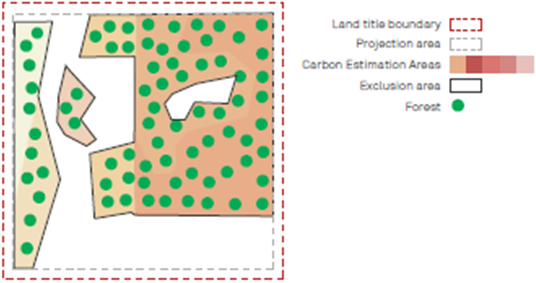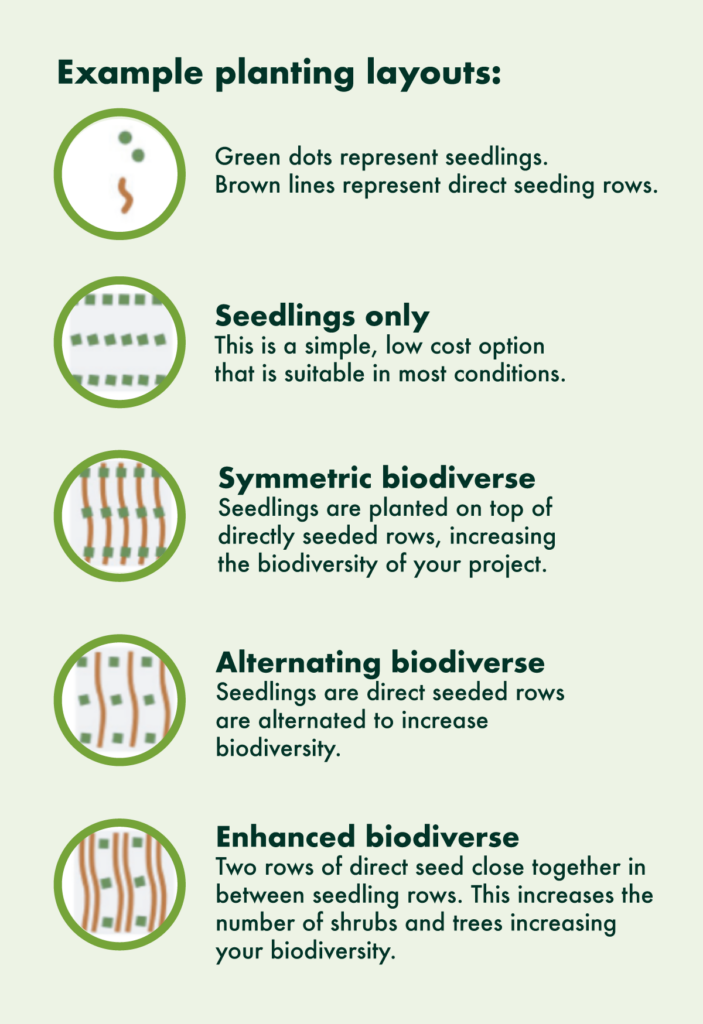A guide to designing your reforestation project
If the feasibility assessment indicates that a project is viable, Landcare Australia will work with you to complete a detailed project design in preparation for project registration submission with the CER. Project design includes analysing the following.
DISCLAIMER: This general information has been prepared by Landcare Australia (AR 1315198 of Australian Carbon Traders Pty Ltd AFSL 425512) for farmers and landholders who are eligible to be treated as wholesale clients. It does not take into account your objectives, needs or situation. ACCUs and derivatives are financial products. While we have outlined common benefits, risks and constraints here, we strongly recommend you seek independent financial and legal advice before acting on any decision to invest. Click here for further regulatory information.
Project Area, Carbon Estimation Areas
The project area is the total area of the reforestation project. It may cover an entire property or a specific area within a property.
The Carbon Estimation Areas (CEAs) are where trees will be planted and carbon sequestered. CEAs need to have uniform characteristics, including soil type, vegetation and slope.
Exclusion areas are areas within the project that are not eligible or cannot have trees planted and therefore will not contribute towards the project. For example, existing forest, dams, roads, sheds etc.
For more information about project areas and CEAs see a guide to the reforestation by environmental or Mallee plantings FullCAM method.
FullCAM modelling
FullCAM modelling will determine the carbon yield for areas on a property. Yields should be considered in the context of on-stie conditions. High carbon yield areas may not necessarily be conducive to tree planting.

Site Characteristics
Assessment of the practical suitability of the land for tree planting will be completed to support the results of the feasibility assessment. This includes:

Soils and topography
Soil conditions which will make it difficult for trees to establish (e.g. salinity). Rocky areas which can’t be ripped or machine planted and may need to be excluded from the project area. Gradients and slopes and impact on machinery access.

Remnant vegetation
Remnant vegetation will be excluded from CEAs. If the vegetation is a known weed species, exclusions may apply.

Threatened species
Identify any threatened species or ecological communities through tools such as the Protected Matters Search Tool or Atlas of Living Australia.

Cultural heritage sites
Undertake a search of relevant government databases to identify cultural heritage sites in the project area.

Ecological benefits
Identify and map opportunities to connect remnant vegetation, create wildlife corridors or provide buffer threatened ecological communities.

Integration with farm business
Incorporate design features such as shade and shelter for livestock, wind breaks, pollinator strips.
Planting Layouts
Selecting the optimal planting layout is critical to optimise tree survival and carbon revenue outcomes. There are a number of different planting layouts that can be used on sites which are influenced by project goals, biodiversity outcomes, budget and forest type.
Species Selection
The species list and amount of seed required to reach the stem density on site will be informed by qualified ecologists. Species must meet method requirements, that is seed must be consistent with vegetation communities on site and consist of native species. You must also be able to demonstrate the resilience of the species to any expected changes in the local climate for the 25 or 100 year permanence period.
Site Preparation
Once planting areas and species have been determined, site preparation requirements will need to be planned for each area. Plantings will have a greater chance of survival and growth if the land has been prepared to enhance soil moisture. Depending on the site, this typically includes weed control and ground preparation such as ripping or scalping. The plan for site preparation is detailed in the Reforestation Management Plan. Site preparation cannot be implemented until after project registration submission.

Reforestation Management Plan (RMP)
For each project, the proponent must create and maintain a RMP to submit with project registration.
Development of the RMP is a key component of project registration. It is a detailed document and takes time to collate.
Key inclusions in the RMP:
- Identification of planting areas and exclusion areas.
- Technical details on planting layout and design. Including:
- Belt, patch, block planting or a combination
- Determine whether to use tube stock, direct seeding or a combination, based on factors such as topography, site access, and presence of weeds.
- Total planting area and row spacing to determine the number of seedlings, seed, and any soil treatment. A carbon farming project needs a minimum of 200 stems per hectare.
- Species list and target number of plants per species. Local (endemic) species are a requirement under the Reforestation method.
- Overview of species growth characteristics and impact on attaining forest cover,
- Description of species suitability and climate adaptability
- Methods to protect the seedlings from stock and native herbivores (i.e., fences, tree guards.
- Highlighting any local or state government approvals that may be needed.
- Timeline and sequence of activities.
- FullCAM modelling to provide an estimate of ACCUs generated.
- Financial modelling of revenue, ACCU price, reforestation costs, % ACCU share from the reforestation project.
- Complete a project risk assessment identifying environmental, technical, financial and operational risks and mitigation measures. Including contingencies for:
- How the project will be monitored. Including short term outputs (e.g. tree survival) and longer term outcomes (e.g. biodiversity enhancement).